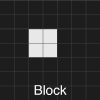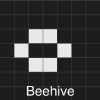| Line 16: | Line 16: | ||
There are some basic patterns occurring frequently: | There are some basic patterns occurring frequently: | ||
[[File:Block.png|100px]] [[File:Beehive.png|100px]] The patterns which remain still for all subsequent generations are called 'Still Lives'. Examples include the “Block” and the “Beehive”. | [[File:Block.png|100px]] [[File:Beehive.png|100px]] <div>The patterns which remain still for all subsequent generations are called 'Still Lives'. Examples include the “Block” and the “Beehive”.</div> | ||
Revision as of 13:40, 1 May 2016
Game of Life and Universal Computation
Game of Life
Life, along with this “Game of Life”, is simply a mathematical model of a self-replicatable machine. It was named “Game of Life” since the rules of the game are similar to life of an organism although over-simplified.
“Game of Life” is played on a theoretically infinite, 2 dimensional square grid where each cell of the grid can take one of two states: “Alive” or “Dead”. The game requires the player to put in an initial pattern of living and dead cells and a program, following some rules, computes the next generation of the pattern. The standard rules of Life are:
- Any live cell with less than 2 live cells in the surrounding 8 cells will die (loneliness)
- Any live cell with more than 3 live cells in the surrounding 8 cells will also die (overcrowding)
- Any live cell with 2 or 3 live cells in the surrounding 8 cells will continue to live to the next generation
- Any dead cell with exactly three live cells in the surrounding 8 cells will come alive (reproduction)
A very good program for exploring cellular automata including “Game of Life” is “Golly”. Operating it is as simple as MS Paint, and it make things much easier to procure the numerous generations.
There are some basic patterns occurring frequently:

